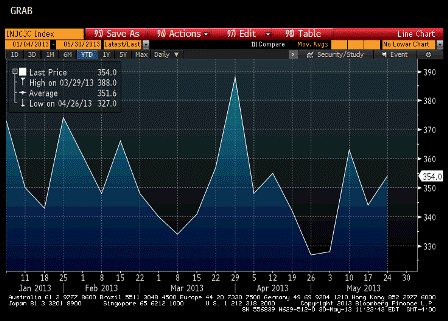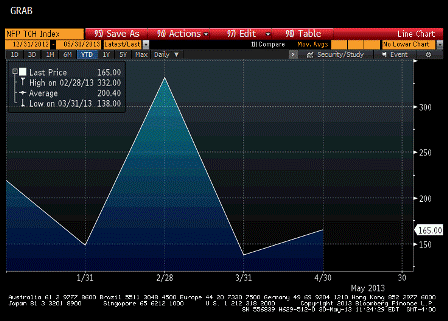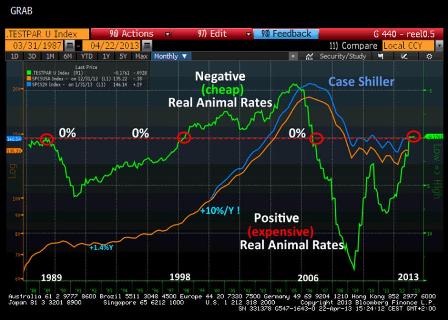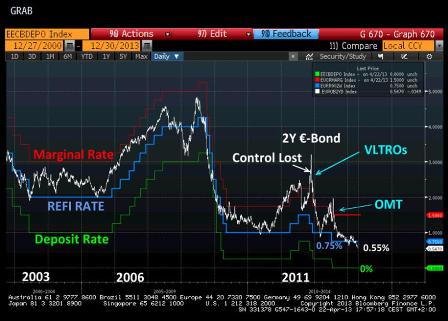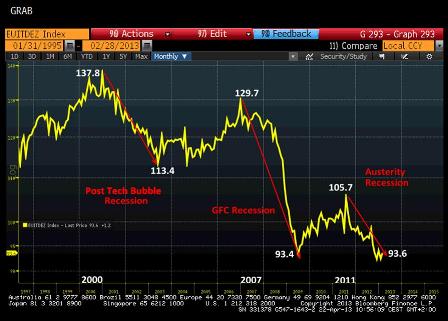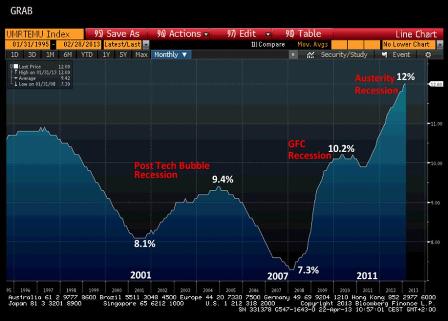Good to see Ken, who I’ve never met, and Carmen who I do know, no doubt assisted by her husband Vince, beginning to come clean with this response. While not complete, it’s the beginning of an encouraging, epic reversal and a first step in the right direction!
My comments added below:
By Kenneth Rogoff and Carmen Reinhart
May 1 (FT) — The recent debate about the global economy has taken a distressingly simplistic turn. Some now argue that just because one cannot definitely prove very high debt is bad for growth (though the weight of the results still say it is),
They could add here ‘though likely via the reaction functions of govts and not the high debt per se.’
then high debt is not a problem. Looking beyond the recent public debate about the literature on debt we have already discussed our results on debt and growth in that context the debate needs to be reconnected to the facts.
Let us start with one: the ratios of debt to gross domestic product are at historically high levels in many countries, many rising above previous wartime peaks. This is before adding in concerns over contingent liabilities on private sector balance sheets and underfunded old-age security and pension programmes. In the case of Germany, there is also the likely need to further cushion the debt loads of eurozone partners.
Adding here ‘as they are ‘users’ of the euro the way US states are ‘users’ of the dollar, and not the actual issuer of the currency like the ECB, the Fed, the BOE, the BOJ, and the rest of the world’s central banks.’
Some say not to worry, pointing to bursts of growth after the world wars. But todays debts,
Add ‘while they pose no solvency risk for the issuer of the currency.’
will not be dealt with by boosts to supply from postwar demobilisation and to demand from the lifting of wartime controls.
To be clear, no one should be arguing to stabilise debt, much less bring it down, until growth is more solidly entrenched if there remains a choice, that is.
BRAVO!!!! And add ‘as is always the case for the issuer of the currency.’
Faced with, at best, haphazard access to international capital markets and high borrowing costs, periphery countries in Europe face more limited alternatives.
Add ‘as is the case for ‘users’ of a currency in general, including the US states, for example’.
Nevertheless, given current debt levels, enhanced stimulus should only be taken selectively and with due caution. A higher borrowing trajectory is warranted, given weak demand
BRAVO!
and low interest rates,
Add ‘which are confirmation by the CB policy makers who set the rates low that they too believe demand is weak’.
where governments can identify high-return infrastructure projects. Borrowing to finance productive infrastructure raises long-run potential growth, ultimately pulling debt ratios lower. We have argued this consistently since the outset of the crisis.
BRAVO! And add ‘additionally, weak demand can be addressed by tax reductions, recognizing that counter cyclical fiscal policy of currency users, like the euro zone members, requires funding support from the issuer of the currency, which in this case is the ECB.’
Ultra-Keynesians would go further and abandon any pretense of concern about longer-term debt reduction.
Add ‘without a credible long term inflation concern, as for the issuer of the currency inflation is the only risk from excess demand.’
This position has been in the rhetorical ascendancy in recent months, with new signs of weaker growth. It throws caution to the wind on debt
Add ‘with regards to solvency, as is necessarily the case for the issuer of the currency.’
and, to quote Star Trek, pushes governments to go where no man has gone before
Add ‘apart from war time, when the importance of maximum output and employment takes center stage.’
The basic rationale
Add ‘of the mainstream deficit doves (not the ultra Keynesian MMT school of thought)’
is that low interest rates make borrowing a free lunch.
Unfortunately,
Add ‘the mainstream believes’
ultra-Keynesians are too dismissive of the risk of a rise in real interest rates. No one fully understands why rates have fallen so far so fast,
Add ‘apart from the Central Bankers who voted to lower them this far and this fast, and in some cases provide guarantees to other borrowers.’
and therefore no one can be sure for how long their current low level will be sustained.
Add ‘as it’s a matter of second guessing those central bankers.’
John Maynard Keynes himself wrote How to Pay for the War in 1940 precisely because he was not blas about large deficits even in support of a cause as noble as a war of survival. Debt is a slow-moving variable that cannot and in general should not be brought down too quickly. But interest rates can change rapidly.
Add ‘all it takes is a vote by central bankers.’
True, research has identified factors that might combine to explain the sharp decline in rates.
Add ‘in fact, all you have to do is research the votes at the central bank meetings.’
Greater concern
Add ‘by central bankers’
over potentially devastating future events such as fresh financial meltdowns may be depressing rates. Similarly, the negative correlation between returns on stocks and long-term bonds, while admittedly quite unstable, also makes bonds a better hedge. Emerging Asias central banks have been great customers for advanced economy debt, and now perhaps the Japanese will be once more. But can these same factors be relied on to keep yields low indefinitely?
Add ‘In the end, it’s all a matter of the central bank’s reaction function.’
Economists simply have little idea how long it will be until rates begin to rise. If one accepts that maybe, just maybe, a significant rise in interest rates in the next decade
Add ‘due to inflation concerns’
might be a possibility, then plans for an unlimited open-ended surge in debt should give one pause.
Add ‘if he does not see the merits of leaving risk free rates near 0 in any case, as there is no convincing central bank research that shows rate hikes reduce inflation rates, and even credible theory and evidence to be concerned that rate hikes instead exacerbate inflation.’
What, then, can be done? We must remember that the choice is not simply between tight-fisted austerity and freewheeling spending. Governments have used a wide range of options over the ages. It is time to return to the toolkit.
First and foremost,
Add ‘only’
governments
Add ‘who fail to recognize that these are merely matters of accounting that don’t themselves alter output and employment’
must be prepared to write down debts rather than continuing to absorb them. This principle applies to the senior debt of insolvent financial institutions, to peripheral eurozone debt and to mortgage debt in the US.
Add ‘Additionally’
For Europe, in particular, any reasonable endgame will require a large transfer
Add ‘of public goods production’
from Germany to the periphery.
Add ‘which in fact would be a real economic benefit for Germany.’
The sooner this implicit transfer becomes explicit, the sooner Europe will be able to find its way towards a stable growth path.
There are other tools. So-called financial repression, a non-transparent form of tax (primarily on savers), may be coming to an institution near you. In its simplest form, governments cram debt into domestic pension funds, insurance companies and banks
By removing governmental support of higher rates from their net issuance of debt instruments, particularly treasury securities.
Europe is there already and it has been there before, several times. How to Pay for the War was, in part, about creating captive audiences for government debt. Read the real Keynes, not rote Keynes, to understand our future.
One of us attracted considerable fire for suggesting moderately elevated inflation (say, 4-6 per cent for a few years) at the outset of the crisis. However, a once-in-75-year crisis is precisely the time when central banks should expend some credibility to take the edge off public and private debts, and to accelerate the process bringing down the real price of housing and real estate.
It is therefore imperative for the central bankers to make it clear to the politicians that there is no solvency risk, and that central bankers, and not markets, are necessarily in control of the entire term structure of risk free rates, and that their research shows that rate hikes are not the appropriate way to bring down inflation, should the question arise’
Structural reform always has to be part of the mix. In the US, for example, the bipartisan blueprint of the Simpson-Bowles commission had some very promising ideas for simplifying the tax codes.
There is a scholarly debate about the risks of high debt. We remain confident in the prevailing view in this field that high debt is associated with lower growth
Add ‘but must add that the risk is that of misguided policy response, and not the level of debt per se.’
Certainly, lets not fall into the trap of concluding that todays high debts are a non-issue.
Add ‘as we must be ever mindful of the possibility of excess demand using up our productive capacity’
Keynes was not dismissive of debt. Why should we be?
The writers are professors at Harvard University. They have written further on carmenreinhart.com

